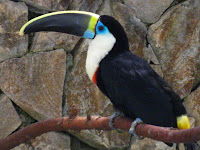



Before crossing the border we weren't really sure what to expect from Ecuador. Apart from the obvious (that it sits on the line between north and south), and the trivial (that its the world's biggest producer of bananas), we really didn't know too much.
Once we'd cleared immigration, the view from the bus changed rapidly from brown desert to lush green - plus flashes of yellow from all those bananas. Approaching Cuenca, a beautiful old colonial city, things seemed more prosperous than either Peru or Bolivia. There were lots of private cars on the roads - not just buses and taxis. There were even littter bins to keep the streets tidy, something we hadn't seen in months...
Cuenca is blessed with several old churches, leafy squares and cobbled streets - the Spaniards built the whole lot next to the old Inca capital, just to stress their domination. At the museum we were given an introduction to Ecuador's different indigenous people. They include the Shuar tribe who, until quite recently apparently, used to carry round the shrunken heads of vanquished enemies - several of them sat grinning in little display cabinets.
A rather less cruel form of torture was inflicted on us the next day - at the Banos steam baths. The thermal waters here are apparently the hottest in Ecuador. After enjoying ten minutes of warmth, a smiling lady came to throw buckets of cold water over us. Ten minutes later, with an even bigger grin, she ushered us out of our little wooden cabins to sit in an icy pool of water. After another ten minutes of steam, she returned once more, this time with a hose pipe. It was invigorating, to say the least.
From Cuenca we travelled north to Riobamba - planning to take a train ride through the mountains. Of course, it was only after we arrived that we found the track is under repair at the moment - so instead we took a ride by horseback. Although it was pretty cloudy on the mountain tops, the views were still spectacular. So far at least, Ecuador seems like a very green and pleasant place to be.























